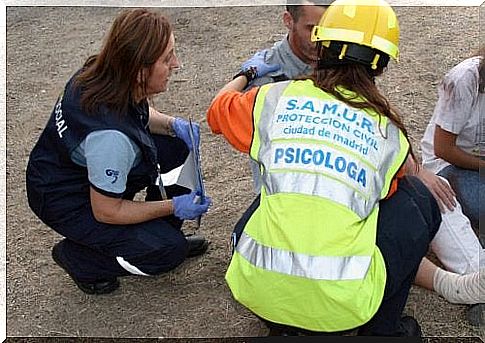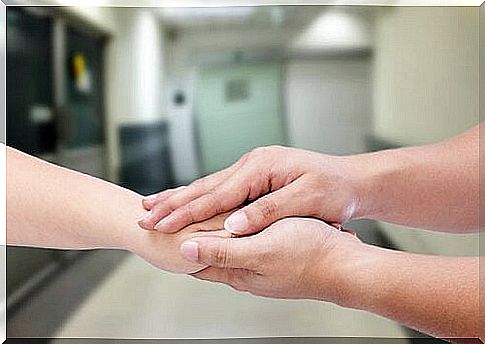What Does It Mean To Report?

Reporting, psychologically, is a rapid intervention that takes place in the first days after a traumatic event. This incident can be a natural disaster (earthquake, flood, etc.), a car accident, etc.
When reporting, a group of colleagues or people who have experienced an event in a similar way will sit down. The aim is to exercise support between the group, among those who have been involved in the same situation in similar circumstances.
The goal is to create a space where members of the group can express their feelings, thoughts and reactions in a safe place. By doing this, it helps against future, mental disorders.
Furthermore, these people can shed emotional burdens from themselves that build up after a traumatic event. A psychologist leads these meetings, and group members tell the story of what happened to them during the incident.
Psychologists designed the technique of reporting, to help people deal with potentially traumatic events. Emergency professionals consider this tool to be a huge help, to avoid aggravation of mental symptoms.

Professionals also suffer
Professionals who help in emergencies are also people. They also suffer, and need help sometimes. They are the forgotten people. These professionals are at high risk of suffering from mental injuries, because of what they do. It is therefore particularly important that they receive immediate assistance after experiencing a traumatic situation.
They are often assigned tasks, regardless of their age, training, skills or experience. This can cause symptoms of acute stress to break out. At other times, the same professionals may not even discover that they are out where they can not bottom out.
Intervention during a disaster does not follow a specific or predictable schedule. Emergencies are constantly changing, which means that professionals must be able to handle diverse and urgent circumstances.
Professionals require numerous resources in their jobs. In emergencies, it is not certain they can follow the book. The professionals must approach the unique characteristics of the situation, and take it from there.
The symptoms that an emergency professional experiences
An emergency professional can experience many symptoms after a disaster. Physiologically, the professional working under pressure may need to deal with fatigue, nausea, chills, or shortness of breath.
They will certainly be alert and alert at a cognitive level. However, they may have negative thoughts, and not be able to know how to stop them. The mental response is a combination of fear, anxiety, irritation and even emotional shock.
At a motor level, the professional may be affected by an inability to sleep, accelerated speech and may begin to shout during a normal conversation. To prevent these symptoms from getting worse, psychologists can use the technique of reporting. That is why it is an exceptional tool.
Why is it important to acknowledge your own stress and respond to it?
The effects of stress on emergency professionals can be devastating. Let’s take a look at some of the effects:
Work:
- Deteriorated quality of work.
- Increased absence.
- Less commitment.
- Multiple conflicts with colleagues (with both superiors and subordinates).
In the home:
- Conflicts with their partner and other family members.
- Negative comments and storytelling that loved ones are not ready to hear.
- Isolation.

How to start the process of reporting
The help that emergency professionals receive should not end in intervention. They mean that they too must be helped after their shift is over. Dealing with negative experiences should be an explicit, organized process.
On the other hand, group support and emotional relief meetings have both followers and critics. Many organizations use these techniques to help people deal with their emotions after experiencing disasters.
These meetings have a set of rules. An expert leads these meetings and all participants share their views on things and how the event has affected them. Furthermore, they also include cognitive and emotional reactions that were experienced during the incident.
When the shift is over or the rescue is complete, a leader should call for a casual meeting with all those who attended the event. In this meeting, participants should be encouraged to:
- Tell about their experience.
- Talk about their feelings.
The leader of the activity should:
- Let participants know the symptoms they may experience or suffer from in the coming days.
- Tell them how to respond to these symptoms.

The stages of reporting
Reporting is not an improvised process. Instead, it is structured, according to the following stages:
- The goals are explained.
- Each member introduces himself and explains what has happened.
- The members describe what they saw, heard and the thoughts they had.
- Each member describes his reactions. The facilitator asks each member to focus on the worst thing they experienced.
- Each member comments on the stress response they experienced immediately after the incident and the stress they are now experiencing.
- The facilitator lets participants know that these reactions are normal and teaches them coping mechanisms.
- The facilitator resolves any doubts. This is the opportunity to say whatever is yet to be said. The facilitator offers additional support.
After reporting, the professionals may still have symptoms. These symptoms include not sleeping, self-criticism about how they acted, a feeling of being misunderstood, and so on.
As we have seen, the stress that arises after an emergency can be really difficult to deal with. That is why reporting should take place within the first 24-72 hours, after the critical incident.
The goal of reporting is to translate suffering into words, structure an event, and release the stress that participants experience. The expert facilitates this in a structured way.
Finally, we must learn to understand and deal with the common reactions that come after a traumatic event. We need to do this in a place where we feel safe, accompanied and guided therapeutically, in the hope of getting better.









